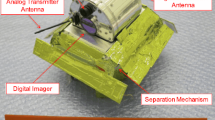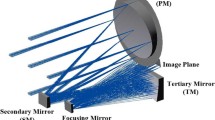Abstract
An artificial impact experiment is scheduled for 2018–2019 in which an impactor will collide with asteroid 162137 Ryugu (1999 \(\mathrm{JU}_{3}\)) during the asteroid rendezvous phase of the Hayabusa2 spacecraft. The small carry-on impactor (SCI) will shoot a 2-kg projectile at 2 km/s to create a crater 1–10 m in diameter with an expected subsequent ejecta curtain of a 100-m scale on an ideal sandy surface. A miniaturized deployable camera (DCAM3) unit will separate from the spacecraft at about 1 km from impact, and simultaneously conduct optical observations of the experiment. We designed and developed a camera system (DCAM3-D) in the DCAM3, specialized for scientific observations of impact phenomenon, in order to clarify the subsurface structure, construct theories of impact applicable in a microgravity environment, and identify the impact point on the asteroid. The DCAM3-D system consists of a miniaturized camera with a wide-angle and high-focusing performance, high-speed radio communication devices, and control units with large data storage on both the DCAM3 unit and the spacecraft. These components were successfully developed under severe constraints of size, mass and power, and the whole DCAM3-D system has passed all tests verifying functions, performance, and environmental tolerance. Results indicated sufficient potential to conduct the scientific observations during the SCI impact experiment. An operation plan was carefully considered along with the configuration and a time schedule of the impact experiment, and pre-programed into the control unit before the launch. In this paper, we describe details of the system design concept, specifications, and the operating plan of the DCAM3-D system, focusing on the feasibility of scientific observations.











Similar content being viewed by others
References
M. Arakawa, T. Saiki, K. Wada, T. Kadono, Y. Takagi, M. Hayakawa, H. Imamura, K. Ogawa, K. Shirai, R. Honda, K. Ishibashi, H. Hayakawa, Small Carry-on Impactor (SCI): its purpose, operation, and observation plan in Hayabusa-2 mission, in Proc. Lunar Planet. Sci. Conf., vol. 44 (2013), p. 1904
M. Arakawa, K. Wada, T. Saiki, T. Kadono, Y. Takagi, K. Shirai, C. Okamoto, H. Yano, M. Hayakawa, S. Nakazawa, N. Hirata, M. Kobayashi, P. Michel, M. Jutzi, H. Imamura, K. Ogawa, N. Sakatani, Y. Iijima, R. Honda, K. Ishibashi, H. Hayakawa, H. Sawada, Scientific objectives of Small Carry-on Impactor (SCI) and Deployable Camera 3 Digital (DCAM3-D): observation of an ejecta curtain and a crater formed on the surface of Ryugu by an artificial high-velocity impact. Space Sci. Rev. (2017). doi:10.1007/s11214-016-0290-z
K.A. Holsapple, The scaling of impact processes in planetary sciences. Annu. Rev. Earth Planet. Sci. 21, 333–373 (1993)
K.R. Housen, K.A. Holsapple, Ejecta from impact craters. Icarus 211, 856–875 (2011)
K. Ishibashi, K. Shirai, K. Ogawa, K. Wada, R. Honda, M. Arakawa, N. Sakatani, Y. Ikeda, Performance of Hayabusa2 DCAM3-D camera for short-range imaging of SCI and ejecta curtain generated from the artificial impact crater formed on asteroid 162137 Ryugu (1999 \(\mathrm{JU}_{3}\)). Space Sci. Rev. (2017). doi:10.1007/s11214-016-0298-4
K. Ishibashi, K. Ogawa, K. Shirai, K. Wada, Y. Ikeda, R. Honda, M. Arakawa, Gamma-ray Irradiation Test of Optical Glasses for Hayabusa2/DCAM3-D. JAXA Research and Development Report, JAXA-RR-15-005 (2016) (in Japanese)
H. Mizutani, S. Kawakami, Y. Takagi, M. Kato, M. Kumazawa, Cratering experiments in sands and a trial for general scaling law. J. Geophys. Res. 88, A835–A845 (1983)
T. Saiki, H. Imamura, H. Sawada, M. Arakawa, T. Kadono, Y. Takagi, K. Wada, Small Carry-on Impactor of Hayabusa2 and Its Impact Operation. Proc. Int. Symp. Space Tech. Sci. 29 (2013)
T. Saiki, H. Imamura, M. Arakawa, K. Wada, Y. Takagi, M. Hayakawa, K. Shirai, H. Yano, C. Okamoto, The Small Carry-on Impactor (SCI) and the Hayabusa2 impact experiment. Space Sci. Rev. (2017). doi:10.1007/s11214-016-0297-5
H. Sawada, O. Mori, N. Okuzumi, Y. Shirasawa, Y. Miyazaki, M. Natori, S. Matsunaga, H. Furuya, H. Sakamoto, Mission report on the solar power sail deployment demonstration of IKAROS, in Proc. AIAA/ASME/ASCE/AHS/ASC Structure, Structural Dynamics Materials Conf., vol. 52 (2011). AIAA 2011-1887
H. Sawada, K. Ogawa, K. Shirai, S. Kimura, Y. Hiromori, Y. Mimasu (DCAM3 Development Team), Deployable Camera (DCAM3) system for observation of Hayabusa2 impact experiment. Space Sci. Rev. (2017). doi:10.1007/s11214-017-0337-9
S. Tachibana, M. Abe, M. Arakawa, M. Fujimoto, Y. Iijima, M. Ishiguro, K. Kitazato, N. Kobayashi, N. Namiki, T. Okada, R. Okazaki, H. Sawada, S. Sugita, Y. Takano, S. Tanaka, S. Watanabe, M. Yoshikawa, H. Kuninaka (Hayabusa2 Project Team), Hayabusa2: scientific importance of samples returned from C-type near-Earth asteroid (162173) 1999 \(\mathrm{JU}_{3}\). Geochem. J. 48, 571–587 (2014)
Y. Takagi, Surface phenomena on solar system small bodies. JASMA. Jpn. Soc. Microgravity Appl. 29, 163–168 (2012) (in Japanese)
Y. Tsuda, M. Yoshikawa, M. Abe, H. Miyamoto, S. Nakazawa, Systemp design of the Hayabusa 2–asteroid sample return mission to 1999 JU3. Acta Astron. 91, 356–362 (2013)
K. Wada, M. Arakawa, T. Saiki, H. Imamura, M. Hayakawa, C. Okamoto, K. Shirai, T. Takagi, T. Kadono, Y. Tsuda, H. Yano, S. Nakazawa, N. Hirata, K. Ogawa, Y. Iijima, P. Michel, M. Jutzi, Large scale impact experiments simulating Small Carry-on Impactor (SCI) equipped on Hayabusa-2, in Proc. Lunar Planet. Sci. Conf., vol. 45 (2014), p. 1768
H. Yano, T. Kubota, H. Miyamoto, T. Okada, D. Scheeres, Y. Takagi, K. Yoshida, M. Abe, S. Abe, O. Barnouin-Jha, A. Fujiwara, S. Hasegawa, T. Hashimoto, M. Ishiguro, M. Kato, J. Kawaguchi, T. Mukai, J. Saito, S. Sasaki, M. Yoshikawa, Touchdown of the Hayabusa spacecraft at the Muses sea on Itokawa. Science 312, 1350–1353 (2006)
M. Yoshikawa, S. Watanabe, Y. Tsuda, H. Kuninaka (Hayabusa2 Project Team), The next asteroid sample return mission of Japan. Trans. JASS Aerosp. Tech. Jpn. 12, 29–33 (2014)
Acknowledgements
The authors gratefully acknowledge the dedicated efforts of Mr. Osamu Nara and the engineers of Meisei Electric Co., Ltd., and Dr. Yuji Ikeda of Photocoding Inc., Japan. We also acknowledge the important advice on the radio communication unit provided by Dr. Tomoaki Toda of the Japan Aerospace Exploration Agency. The authors thank two anonymous reviewers for helpful comments that improved this paper.
Author information
Authors and Affiliations
Corresponding author
Rights and permissions
About this article
Cite this article
Ogawa, K., Shirai, K., Sawada, H. et al. System Configuration and Operation Plan of Hayabusa2 DCAM3-D Camera System for Scientific Observation During SCI Impact Experiment. Space Sci Rev 208, 125–142 (2017). https://doi.org/10.1007/s11214-017-0347-7
Received:
Accepted:
Published:
Issue Date:
DOI: https://doi.org/10.1007/s11214-017-0347-7




